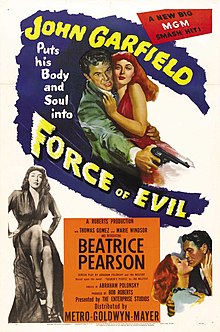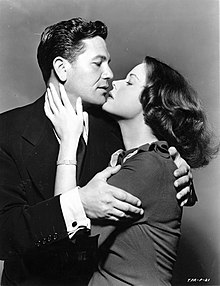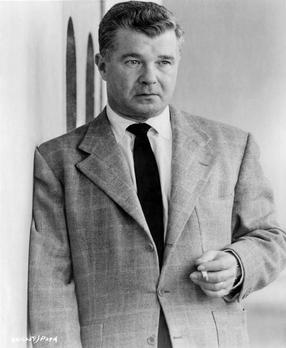
Robert Rossen was an American screenwriter, film director, and producer whose film career spanned almost three decades.

Body and Soul is a 1947 American film noir sports drama directed by Robert Rossen and starring John Garfield, Lilli Palmer, Hazel Brooks, Anne Revere, and William Conrad. The screenplay by Abraham Polonsky is partly based on the 1939 film Golden Boy. With cinematography by James Wong Howe, the film is considered by some to be one of the best films about boxing. It is also a cautionary tale about the lure of money—and how it can derail even a strong common man in his pursuit of success. The film uses the song Body and Soul for the main musical theme and underscoring throughout.
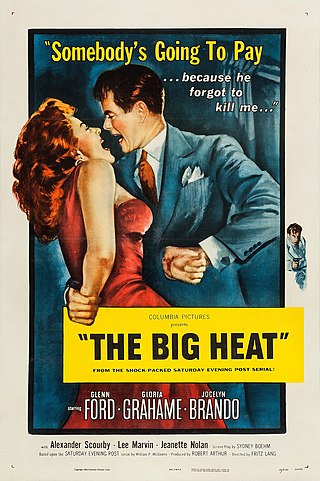
The Big Heat is a 1953 American film noir crime film directed by Fritz Lang starring Glenn Ford, Gloria Grahame, and Jocelyn Brando about a cop who takes on the crime syndicate that controls his city.
Abraham Lincoln Polonsky was an American film director, screenwriter, essayist and novelist. He was nominated for an Academy Award for Best Original Screenplay for Body and Soul but in the early 1950s was blacklisted by the Hollywood movie studios, after refusing to testify at congressional hearings of the House Un-American Activities Committee, in the midst of the McCarthy era.

The Killers is a 1946 American film noir starring Burt Lancaster, Ava Gardner, Edmond O'Brien, and Sam Levene. Based in part on the 1927 short story of the same name by Ernest Hemingway, it focuses on an insurance detective's investigation into the execution by two professional killers of a former boxer who was unresistant to his own murder. Directed by Robert Siodmak, it featured an uncredited John Huston and Richard Brooks co-writing the screenplay, which was credited to Anthony Veiller. As in many film noir, it is mostly told in flashback.
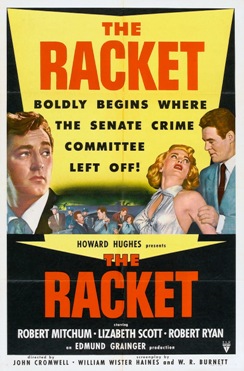
The Racket is a 1951 black-and-white film noir drama directed by John Cromwell with uncredited directing help from Nicholas Ray, Tay Garnett, and Mel Ferrer. The production features Robert Mitchum, Lizabeth Scott, Robert Ryan, and William Conrad. Future Perry Mason regular cast members William Talman and Ray Collins appear in key roles.
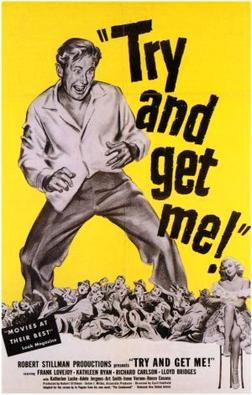
The Sound of Fury is a 1950 American crime film noir directed by Cy Endfield and starring Frank Lovejoy, Kathleen Ryan, Richard Carlson. The film is based on the 1947 novel The Condemned by Jo Pagano, who also wrote the screenplay.

Nobody Lives Forever is a 1946 American crime film noir directed by Jean Negulesco and based on the novel I Wasn't Born Yesterday by W. R. Burnett. It stars John Garfield and Geraldine Fitzgerald and features Walter Brennan, Faye Emerson, George Coulouris and George Tobias.
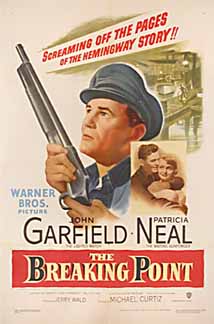
The Breaking Point is a 1950 American film noir crime drama directed by Michael Curtiz and the second film adaptation of the 1937 Ernest Hemingway novel To Have and Have Not. It stars John Garfield, in his penultimate film role, and Patricia Neal. Subsequently blacklisted by HUAC, Garfield's very last film was the self-produced and self-financed, He Ran All the Way.
The Phenix City Story is a 1955 American film noir crime film directed by Phil Karlson for Allied Artists, written by Daniel Mainwaring and Crane Wilbur and starring John McIntire, Richard Kiley, and Kathryn Grant. It had a triple premiere held on July 19, 1955 in Phenix City, Alabama, Columbus, Georgia, and Chicago, Illinois.

White Heat is a 1949 American film noir directed by Raoul Walsh and starring James Cagney, Virginia Mayo and Edmond O'Brien.

The Velvet Touch is a 1948 American film noir drama directed by Jack Gage and starring Rosalind Russell, Leon Ames, Leo Genn and Claire Trevor.
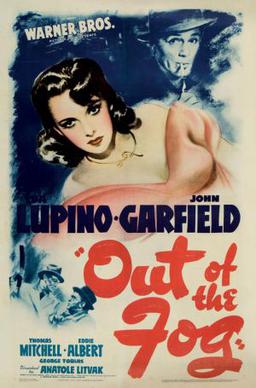
Out of the Fog is a 1941 American film noir crime drama directed by Anatole Litvak and starring John Garfield, Ida Lupino and Thomas Mitchell. The film was based on the play The Gentle People by Irwin Shaw. It was made and released by Warner Brothers.
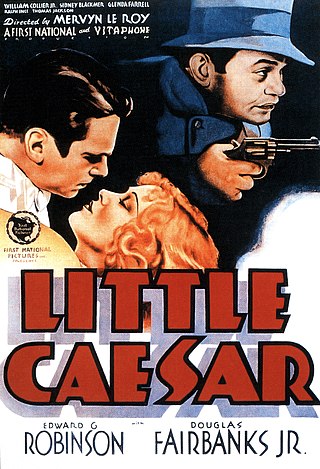
Little Caesar is a 1931 American pre-Code crime film distributed by Warner Brothers, directed by Mervyn LeRoy, and starring Edward G. Robinson, Glenda Farrell, and Douglas Fairbanks Jr. The film tells the story of a hoodlum who ascends the ranks of organized crime until he reaches its upper echelons.
Ira Wolfert was an American Pulitzer Prize-winning war correspondent and a fiction and non-fiction writer.

So Evil My Love is a 1948 British and American Gothic psychological thriller film directed by Lewis Allen and starring Ray Milland, Ann Todd and Geraldine Fitzgerald.

711 Ocean Drive is a 1950 American crime film noir directed by Joseph M. Newman and starring Edmond O'Brien, Joanne Dru and Otto Kruger.

The Naked Street is a 1955 American crime film noir directed by Maxwell Shane. The drama features Farley Granger, Anthony Quinn and Anne Bancroft.

Black Hand is a 1950 American film noir directed by Richard Thorpe and starring Gene Kelly as an Italian immigrant fighting against the Black Hand extortion racket in New York City in the first decade of the 20th century.

The Good Humor Man is a 1950 American slapstick noir action comedy film directed by Lloyd Bacon and written by Frank Tashlin. The film revolves around a Good Humor ice cream salesman who becomes involved in a murder. The film stars Jack Carson, Lola Albright, Jean Wallace, George Reeves, Peter Miles and Frank Ferguson. The film was released on June 1, 1950, by Columbia Pictures.
